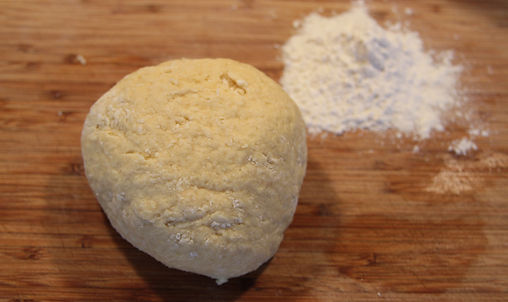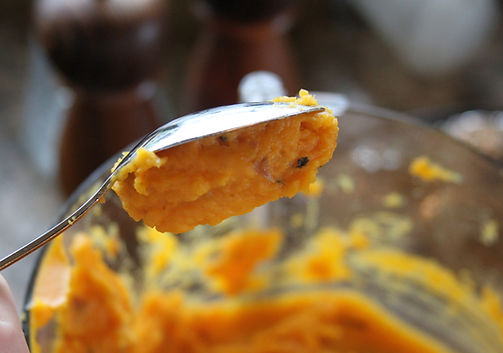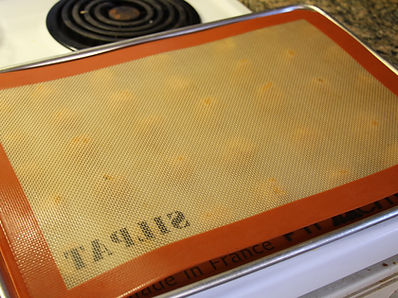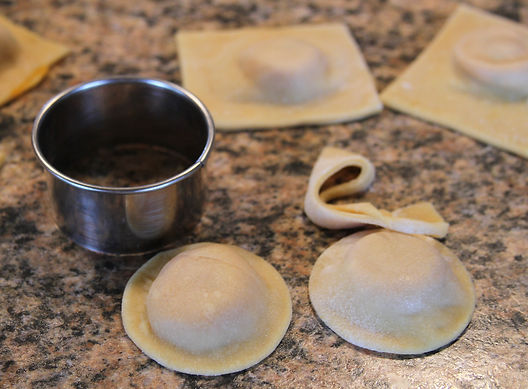The
Corvallis Carrot Organic Meal Prep
The
Corvallis Carrot Organic Meal Prep
BUTTERNUT SQUASH RAVIOLI
INGREDIENTS:
1.5 lb roasted butternut squash
salt and pepper to taste
1.5 c AP flour
3 eggs
1t butter
2 sage leaves
extra flour for dusting
Prep time: about an hour
yield: 4-5 servings

I'm not going to lie, these look a lot better than they tasted. This was my first time making ravioli, so next time I'm expecting a better result. I've made other noodles before, but not ravioli. I'm pretty sure they just had to be rolled out a little thinner than they were. The flavor was spot on, but the actual pasta was very chewy. Hopefully if you attempt these you'll have a little better luck. Cooking is all about experimentation and learning from your mistakes.

Now is the time to pull out the other half of your roasted butternut squash. Peel off the skin. I use a spoon to really scrape the flesh off if it doesn't peel off easily.

Put squash, onions and herbs in food processor.
Occasionally scrape down sides with metal spatula.





Put your eggs in a bowl and scramble with a fork.
Mix flour into the eggs using a fork. This recipe is from an Italian friend. He said it's embarassing how simple pasta can be and that most Italians don't add oil or extra water to the dough, that's an American thing.
You can put the eggs and flour in your food processor, but this recipe is so small you don't really need to.
Stir in the flour with the fork until it's not sticky anymore, then switch to your hands. Gather together all of the extra flour by pressing the dough up against the bowl.


Quick video on kneading dough.
Put dough onto lightly floured surface and begin to knead. I like to have about 1/2 a cup of flour that I can put on the dough if it begins to get sticky.
I normally knead with both hands, but my husband was shooting the video right over my left shoulder, so I wasn't able to use it. Also I like to knead directly on my counter, but the pattern is a little busy, that's why I put it on the cutting board. You can use a wet towel under your cutting board to prevent it from sliding around.
When your dough is soft (you can push your thumb into it and it makes an indent), but dry (not sticking to the cutting board or counter) place it in a plastic bag and let it rest for at least halk an hour. You need to let the gluten relax.

While your pasta dough is resting you can work on the filling.


The mixture will be pretty thick, it should stick to the back of a spoon, but you need to reduce a little more liquid.



In a pan, spread out your mixture. Turn on medium heat.

The steam will create bubbles, occasionally scrape the mixture and turn it with the spatula.
The mixture will start drying out and will begin sticking to itself, forming a ball.
Portion out mixture and put it on a sheet pan to freeze.
You can also pipe mixture directly onto pasta. Freezing makes the portions a little easier to handle.
Portioning the squash.
Place a silpat (or piece of parchment paper) on top of the sqash and press down with another sheet pan. This will uniformly press all of the portions into discs for ravioli.

Remove dough from plastic bag and divide in half. Put one piece ack into the bag so it doesn't dry out.



Place in freezer while you roll out pasta.
I like to start off with the dough in a semi-rectangular shape so I shape it with my hands before I start rolling it with a pin.

Roll dough out.

Fold dough in half.
Rotate clockwise and roll out again.


Repeat folding step 3 times. Folding and rotating helps tighten the gluten so the dough won't fall apart in the water.
Dough will be smooth and elastic.


Roll out into a long, wide strip.

Flour coutertop and let the first piece of dough rest while you roll out the second piece.


Dough should be paper thin. I should have rolled a little thinner. You should be able to see your hand through the dough.

Place portioned squash on dough.

Create egg wash with 1 yolk and stroke onto dough.


Place the other sheet of dough directly over top of squash. Press down around each piece to push out all of the air. Don't try getting rid of the air by poking a hole in the pasta, this will let water into your ravioli and will ruin the filling.



I like to use a wheel cutter to trim off edges and cut pieces. I use this plasic cutter (for fondant) because a metal cutter would damage my counters.


Trim the extra dough off with a round cutter. You can save the scraps for noodle soup if you want.
Bring water to a boil and add ravioli. Turn down the heat. You don't want it boiling after you throw in the ravioli because the ravioli is too delicate. It will start to float when it's finished. About 5 minutes.


Start browning your butter and cut up sage.

Pull ravioli from water and throw into butter, be careful of splattering fat, add sage and toss until ravioli is covered in butter. Finish with asiago or parm cheese. Enjoy.
